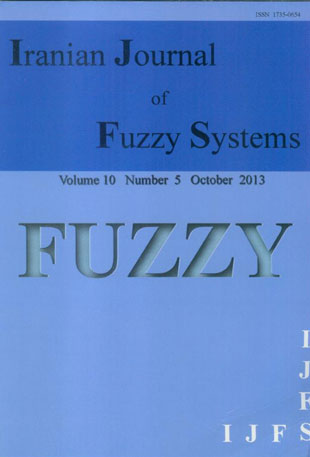فهرست مطالب

Iranian journal of fuzzy systems
Volume:10 Issue: 5, Oct 2013
- 180 صفحه،
- تاریخ انتشار: 1392/08/20
- تعداد عناوین: 9
-
-
Page 1As a generalization of the triple I method, the universal triple I method is investigated from the viewpoints of both fuzzy reasoning and fuzzy controller. The universal triple I principle is put forward, which improves the previous triple I principle. Then, unified form of universal triple I method is established based on the (0,1)-implication or R-implication. Moreover, the reversibility property of universal triple I method is analyzed from expansion, reduction and other type operators, which demonstrate that its reversibility property seems fine, especially for the case employing the (0,1)-implication. Lastly, we analyze the response ability of fuzzy controllers based on universal triple I method, then the practicability of triple I method is improved.Keywords: Fuzzy reasoning, Fuzzy controller, Interpolation mechanism, Reversibility property, CRI method
-
Page 25The purpose of this study has been concretized in terms of impact of mobile advertising on the purchase decision of the consumer and aimed to answer to research questions: which is the underlying structure of criteria in mobile advertising? And which criteria are important for consumers in evaluatingmobile advertising? A sample of consumers in Taiwan was surveyed and using fuzzy judgment to determine the vague perception of consumers. In addition, the proposed fuzzy linguistic preference relation (FLPR) is used to express the subjective preferences of consumers with respect to the considered criteria of mobile advertising, and also use the criterion gauges to evaluate the implementation of mobile advertising strategies. Finally, an empirical study is illustrated to demonstrate that the proposed method is more suitable than the traditional method, especially when the consumerjudgments are likely be inconsistent in pair-wise comparison. The presented fuzzy linguistic preference relation method is an easy and practical way to provide a mechanism for improving consistency in perceptual measure of mobile advertising.Keywords: Perceptual measure, Mobile advertising, Fuzzy linguistic preference relation
-
Page 47In this paper, an optimization problem with a linear objective function subject to a consistent finite system of fuzzy relation inequalities using the max-product composition is studied. Since its feasible domain is non-convex, traditional linear programming methods cannot be applied to solve it. We study this problem and capture some special characteristics of its feasible domain and optimal solutions. Some procedures are proposed to reduce and decompose the original problem into several sub-problems with smaller dimensions. Combining the procedures, a new algorithm is proposed to solve the original problem. An example is also provided to show the efficiency of the algorithm.Keywords: Fuzzy relation inequality, Linear objective function optimization, Max, product composition, Non, convex programming
-
Page 63In this paper، the definition of meet-continuity on $L$-directed complete posets (for short، $L$-dcpos) is introduced. As a generalization of meet-continuity on crisp dcpos، meet-continuity on $L$-dcpos، based on the generalized Scott topology، is characterized. In particular، it is shown that every continuous$L$-dcpo is meet-continuous and $L$-continuous retracts of meet-continuous $L$-dcpos are also meet-continuous. Then، some topological properties of meet-continuity on $L$-dcpos are discussed. It is shown that meet-continuity on $L$-dcpos is a topological invariant with respect to the generalized Scotttopology، and meet-continuity on $L$-dcpos is hereditary with respect to generalized Scott closed subsets.Keywords: $L$, dcpo, Generalized Scott topology, Meet, continuity
-
Page 79In this paper, we present a revised similarity measure based on Chen-and-Chen''s similarity measure for fuzzy risk analysis. The revised similarity measure uses the corrected formulae to calculate the centre of gravity points, therefore it is more effective than the Chen-and-Chen''s method. The revised similarity measure can overcome the drawbacks of the existing methods. We have also proposed a new similarity measure between type-2 fuzzy numbers and a method for handling fuzzy risk analysis problem.Keywords: Fuzzy numbers, Similarity measure, Fuzzy risk analysis, Interval valued fuzzy number, Type, 2 fuzzy number
-
Page 97Bentea and Tu{a}rnu{a}uceanu~(An. c{S}tiinc{t}. Univ. Al. I. Cuza Iac{s}, Ser. Nouv{a}, Mat., {bf 54(1)} (2008), 209-220) proposed the following problem: Find an explicit formula for the number of fuzzy subgroups of a finite hamiltonian group of type $Q_8times mathbb{Z}_n$ where $Q_8$ is the quaternion group of order $8$ and $n$ is an arbitrary odd integer. In this paper we consider more general group: the direct product of a generalized quaternion group of any even order and a cyclic group of any odd order. For this group we give an explicit formula for the number of fuzzy subgroups.Keywords: Generalized quaternion group, Hamiltonian group, Fuzzy subgroups, Subgroup chain, Generating function
-
Page 113In this paper,~some results on finite dimensional generating spaces of quasi-norm family are established.~The idea of equivalent quasi-norm families is introduced.~Riesz lemma is established in this space.~Finally,~we re-define B-S fuzzy norm and prove that it induces a generating space of quasi-norm family.Keywords: Quasi, norm, ~Generating space, ~Fuzzy norm, ~ t, norm
-
Page 127In this paper, new definitions of $L$-fuzzy closure operator, $L$-fuzzy interior operator, $L$-fuzzy remote neighborhood system, $L$-fuzzy neighborhood system and $L$-fuzzy quasi-coincident neighborhood system are proposed. It is proved that the category of $L$-fuzzy closure spaces, the category of $L$-fuzzy interior spaces, the category of $L$-fuzzy remote neighborhood spaces, the category of $L$-fuzzy quasi-coincident neighborhood spaces, the category of $L$-fuzzy neighborhood spaces are all isomorphic to the category $L$-{bf FCS} of $L$-fuzzy closure system spaces.Keywords: $L$, fuzzy closure system, $L$, fuzzy closure operator, $L$, fuzzy interior operator, $L$, fuzzy remote neighborhood, $L$, fuzzy quasi, coincident neighborhood, $L$, fuzzy neighborhood, Isomorphism of categories
-
Page 147In this paper, we discuss the equivalent conditions of pretopological and topological $L$-fuzzy Q-convergence structures and define $T_{0},~T_{1},~T_{2}$-separation axioms in $L$-fuzzy Q-convergence space. {Furthermore, $L$-ordered Q-convergence structure is introduced and its relation with $L$-fuzzy Q-convergence structure is studied in a categorical sense}.Keywords: $L$, fuzzy Q, convergence, $L$, ordered Q, convergence, $L$, filter, Category theory, Separation axioms

